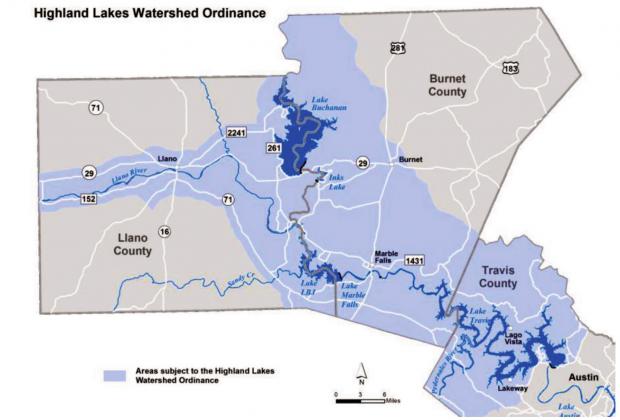Burnet County Judge James Oakley said Thursday, May 6, he hopes the Lower Colorado River Authority (LCRA) will be more forthcoming in the future about how it implements the Highland Lakes Watershed Ordinance, which governs development within the Highland Lakes watershed.
“We want water quality, but where’s the science behind (the ordinance) and why isn’t it fairly applied in all of the counties?” Oakley asked.
Oakley said he will be working with Precinct 1 Commissioner Jim Luther Jr. and Precinct 4 Commissioner Joe Don Dockery, whose precincts are most impacted by the ordinance, as well as County Attorney Eddie Arredondo to press LCRA to answers about the ordinance and its implementation.
Burnet County officials, contractors and builders alike recently voiced their concerns about the impact the LCRA’s actions have on their ability to conduct business and the cost it adds to their bottom line.
Burnet County commissioners heard stories at their March 23 meeting from several parties that LCRA has not responded in a timely manner to permit requests or has used the watershed ordinance to require questionable and costly changes that have delayed and, in some cases, “killed development.”
“We have questions about why is the ordinance there, what is it based on and why is it limited as to who it applies to,” said County Judge James Oakley. “There are some questions that need to be answered and I think there is a lot of room for a lot of improvement (by LCRA). This is nothing personal, but we need to find a better resolve of what is responsible and what makes sense and what is fair.
“Our citizens have complained. We are elected to represent the citizens and we are accountable, but there doesn’t seem be any accountability on (LCRA’s) end.”
Oakley said it seems illogical to him that more than half of the county (about 52 percent) is subject to LCRA’s more-restrictive watershed ordinance, while the remaining 48 percent — mostly in the northern and eastern part of the county along the San Gabriel River — falls under the Brazos River Authority, which appears to defer to local counties to their own governance regarding permitting for septic systems and dealing with stormwater runoff issues.
LCRA combined its two separate nonpoint source pollution control ordinances covering the Lake Travis watershed and the Upper Highland Lakes watershed into a single Highland Lakes Watershed Ordinance (HLWO) in 2006.
According to the LCRA, the ordinance requires development within a specified area to protect water quality and reduce creek erosion and manage stormwater runoff by providing approved water quality management facilities, buffer zones, temporary erosion and sediment control, and permanent systems to minimize sediment migration from the site.
That specified area is the Lake Travis watershed in Travis County, the Colorado River watershed in Burnet County and the portion of Llano County adjoining the Llano River and the Highland Lakes. Burnet, Llano and Travis counties are the statutory counties which border the Highland Lakes.
Under the HLWO, a permit is required for:
• Any development or redevelopment that creates more than 10,000 square feet of impervious cover or disturbs more than one acre of land;
• Any development or redevelopment of a subdivision that will result in more than 10,000 square feet of impervious cover;
• General utility construction;
• New quarry and mining activity that creates more than 10,000 square feet of impervious cover or disturbs more than five acres of land; and
• Dredge and fill projects that dredge more than 500 cubic yards or disturb more than 500 feet of shoreline.
Permits are not needed for agricultural activities, mines of quarries active before March 1, 2007, or development in a jurisdiction that administers LCRA’s ordinance or its own water quality program.
In a letter to Oakley, Bill Lauderback, LCRA executive vice president for public affairs, called LCRA “a steward of the lower Colorado River” and said the organization “has a responsibility to protect the water quality in the Highland Lakes and lower Colorado River.
“To help meet that responsibility, LCRA administers the Highland Lakes Watershed Ordinance to help protect the lakes from pollution found in stormwater runoff, including pesticides, soil, debris, sediment, oil and grease, nutrients, and other contaminants,” Lauderback wrote.
“LCRA determined the areas under the HLWO jurisdiction after considering proximity to the Highland Lakes and major tributaries and area growth projections.”
During the commissioners court meeting, Bob Childress, owner of Childress Septic & Design of Marble Falls, noted LCRA statutorily must approve a permit within 30 days of it being declared “administratively complete.”
“Either they won’t respond at all and on some of these permits, we haven’t heard anything, but if you start challenging them, they’ll come out and look at it and they will kick it back and say, ‘well, you didn’t sign page 24, so now we get another month,’” Childress said. “It’s a lot of piddly stuff. Sometimes there is legitimate stuff, and you respond right back, but the clock adds another 30 days and that is killing our homeowners.
“It’s killing our builders, it’s killing everybody. In Burnet County (in the Brazos watershed), if I give (Development Services Director Herb Darling) the same thing, it’s more like 30 minutes or an hour for him to respond to our application. It just takes minimal time to get an approval. It just doesn’t make any sense at all and it’s really the homeowners who are taking the hit on this.”
Delays and changes caused by LCRA can add, on average, an extra $1,000 to the cost to homeowners to have a septic system installed, Childress said.
A.B. Walters, who owns the Airy Mount property east of Burnet off Texas 29, said he attempted to build a three-restaurant project on the property three to four years ago.
“We called in the LCRA to understand what the rules were and we hired an engineer to work with them,” Walters said. “Forty thousand dollars and 18 months later, it was that same old ‘30 days.’ Everytime you had a discussion with them, it was ‘well, 30 days later, we will talk to you.’ That took 18 months.
“During the process, we started the construction we could do under our City of Burnet permits, but six months into the project, we had to stop construction because LCRA dragged their feet. We lost all of our subs and we had to put the contract on hold.”
Walter said LCRA’s final decision would required him to “raise the level of almost six acres by three feet” and to put in a very costly and questionable drainage system when “a simple retention pond that would have caught and filtered water before it ran off into the watershed would have done the job.”
“That would take hundreds and hundreds of truckloads of dirt and gravel,” Walters said. “That’s just site development. We would have had to go out to someone else’s property, dig up the topsoil and surface for probably 50 acres and haul in dirt so we can raise the level three feet so it has the slope they want.
“The final bid to do what they legislated would have been $1.3 million. As you can see, the Airy Mount project has not been completed today.”
Walters said Airy Mount is just 1.2 miles from the start of the Brazos River watershed “so if I had moved the project 1.2 miles, the project would have been finished and you would have an opportunity to eat at those three restaurants today.
“That’s the difference between being in the Brazos and the LCRA jurisdiction. It is a detriment to Burnet County and to everyone that lives in Burnet County and an unnecessary expense that needs to be stopped somehow.”
“These are the types of stories that are real bad on my blood pressure,” Precinct 4 Commissioner Joe Don Dockery said.
“Five years ago, we used to hear these stories about one per month and now we hear them about one or two a week and they are very similar to Mr. Walters’ story and Mr. Childress’ story,” Precinct 1 Commissioner Jim Luther added. “These are just two stories of probably 50 to 100 that I know of.”
Homebuilder Richard Savage said he was told recently by LCRA that a project previously approved for an off-site septic drain field will now have to install an on-site septic system without the opportunity to have it grandfathered in.
“I can tell you that has a detrimental effect on the value of a property to have to put something on site in a limited amount of area that you no longer have to do that, so you have to change what the footprint of the home looks like and you devalue the property,” Savage said. “There seems to be some inconsistencies and it’s very difficult to get hold of people. You feel like you are dealing with a huge bureaucracy and there is no way to get through it and at the end of the day, those delays end up costing everyone money.
“If it was doing something beneficial to water quality or stopping things that shouldn’t happen, that’s one thing. We’re talking about vanilla stuff that’s real simple and let’s just get it through the system.”



